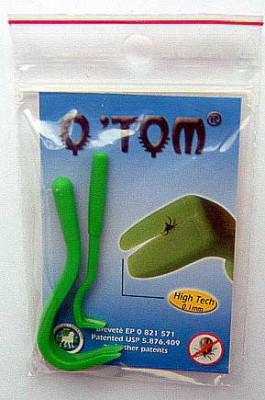How to Properly Remove a Tick from a Dog
It is summertime here in the USA, when the living is easy — unless you have a dog who spends lots of time in the outdoors. Spring and summer are the most active and prolific seasons for ticks, especially this summer. Ticks are going to be a big problem this year because of the relatively mild winter we’ve had across the United States. That type of weather pattern is particularly conducive to seeing lots of them. Read on for information on how to remove a tick from a dog.
Ticks are dangerous because they can transmit much more than Lyme disease. In fact, some species can emit as many as four or five different pathogens – infecting humans and dogs. If a large number of ticks infest a dog, they can suck so much blood that your pet can become anemic — a good reason to nip the prospect of ticks in the bud.
Fortunately, there’s preventive medicine that can protect your pet from picking them up in the first place, as well as foolproof techniques to remove them. But there are also popular myths out there that won’t actually fix the problem.
Common Tick Removal Myths
Petroleum jelly, burning them off, freezing them off, nail polish. These are just a few of the common folk remedies that pop up when you google tick removal. All of them won’t work — and have the potential to further hurt your pet.
Ticks do not back out once attached. Their head remains embedded in the animal’s skin. And this is precisely the problem with petroleum jelly and nail polish: Pet owners think that they can drown or kill the tick, but the head stays in place.
Then there’s the burning method. Fact: Lighting a match anywhere near your pet is the very definition of playing with fire. This should be common sense. Your dog has hair and that hair could be singed or catch on fire.
Some owners try to freezing ticks, which they do by using an aerosol-based liquid freezing gel. We recommend you not toy with this method. You’re not a veterinary professional, so you won’t know how long to hold it on. You could injure your dog.
The other myth often heard: Once you successfully take a tick off, you can burn it. The tick is actually toxic. When it pops, it can let off a toxic fume that can be harmful to pets and infants.
Correct Tick Removal
There are a number of tick-removal tools on the market all over the world. All claim to be safe and efficient but this may not always be the case. The most important aspects of tick removal are:
- The mouth parts of the tick should be cleanly removed along with the rest of its body.
- The body of the tick must not be compressed.
- The tick should not be stressed or injured, because this can cause it to regurgitate its blood meal along with any infective organisms.
- The tick should be removed without causing the host any discomfort.
The Best Way to Remove a Tick
There is a better way than pulling them out using tweezers.
 The latter is a tool that’s specially designed for safely and quickly removing ticks. There are a couple of types to choose from. One functions as blunt-ended, plastic tweezers called a Tick Twister or a Tick Stick. The other is called the Tick Key, a little gizmo that resembles a bottle opener. The hole in it comes down to a very thin point, so you can kind of slip the tick into this hole, slide the tick down to the end and basically lift — just like you would remove a cap off a bottle — and it pulls the tick out.
The latter is a tool that’s specially designed for safely and quickly removing ticks. There are a couple of types to choose from. One functions as blunt-ended, plastic tweezers called a Tick Twister or a Tick Stick. The other is called the Tick Key, a little gizmo that resembles a bottle opener. The hole in it comes down to a very thin point, so you can kind of slip the tick into this hole, slide the tick down to the end and basically lift — just like you would remove a cap off a bottle — and it pulls the tick out.
Your technique is equally important: Start by parting your dog’s fur where you see a tick, and then “pull it out by the body, so as not to twist or pinch the head off.
Once you’ve removed a tick, there are a couple of ways to banish it for good. If you just have a tick or two, you can put them on a piece of tape, so they can’t move, and flush them down the toilet.
Be warned: Flushing alone may not do the trick. You don’t want to flush a live tick down the toilet because they can crawl back up. Not to mention that tape isn’t septic system friendly.
Putting them in rubbing alcohol however, will kill them. We suggest pouring a little alcohol into a bottle, dropping in the tick and then waiting five minutes until you’re sure that the tick has met its match.
Why is it safe to twist with this tool?
When using tweezers/forceps, the tick is grabbed close to the skin. Twisting the tick then exerts pressure to its mouth parts, which can cause them to break off. The Tick Twister cradles the body of the tick and doesn’t exert pressure to either its mouth parts or its abdomen. It can therefore be safely twisted, which allows the barbs on the tick’s proboscis to be freed from the surrounding tissue. Because the tool doesn’t cause any compression to the body of the tick, it minimizes the risk of disease transmission.
The Tick Twister is suitable for the removal of ticks from both humans and animals and can be disinfected with normal disinfectants or sterilized in an autoclave at 284°F (140°C). The product is made from recyclable plastic, which can also be incinerated without pollution (no chlorine fumes during combustion).
Protect Your Pet Before You Have a Tick Problem
The best way to protect your pet from ticks is to apply a monthly flea and tick preventative.
However not all tick preventers are created equal. Flea and tick collars are not as affective because they’re localized around the neck. Since fleas and ticks tend to latch on near the neck, the rump and in the crooks of a dog’s legs, most collars won’t provide complete coverage.
So how do you know if your pet requires professional care? If you notice a large red ring developing — regardless of whether there are 1 or 100 ticks — that’s evidence of the migration of pathogens, and a good sign that veterinary treatment will be effective.
The second red flag is the actual tick count: A lone tick isn’t reason enough for a visit. However any dog who has a lot of ticks needs to seek prompt professional attention.
Bottom line: Seek out preventive care, and give your dog (along with yourself and any kids in your home) a thorough going-over on a daily basis to help ensure a carefree — and tick-free — summer.




Do you recommend using spirulina on dogs to help them with tick problems?
I use a tick spoon that has a notch much like the tool pictured. It works like a charm and I carry one with me on my keychain as well as keeping two others handy at home.
Please note that the flea/tick collars are not very effective (not affectlve). No need to publish, just please edit your copy. It lends weight to your words when they are correct.
How much does one of the tick removers retail for? I’ve seen
That they are sold at fuzzypantspetshop in Massachusetts? I have not seen them in California yet.